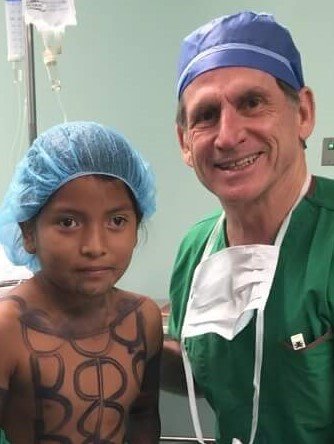Dr. Ken Wright: A Lifelong Dedication to Transforming Pediatric Eye Care By Writer and Contributor Emily McGinn
Dr. Ken Wright, a pediatric ophthalmologist, has helped revolutionize the field of eye surgery over the course of his career. He has become world-famous in his field through writing breakthrough papers and bestselling books about how to conduct eye surgeries to correct issues such as double vision, crossed eyes and eye misalignment.
Originally from the Torrance area, Wright entered the medical field with the intention of becoming a family medicine doctor. However, he managed to snag a USC residency position for ophthalmology because another doctor dropped out of the program.
“By pure luck, I got into the eye program and loved pediatrics,” Wright says.
For Wright, finding new ways to help children with eye disorders is personal. His sister became blind in one eye due to a cataract that was left untreated when she was a baby. As a result, her eye drifted and other children in school would call her a witch because of it. Seeing how the bullying hurt his sister impacted Wright.
“She mentioned that when I would take her to her eye exams as the older brother, one time I told her I’m going to be an eye doctor and I’m not going to let this happen to any other children,” Wright says. “I had forgotten that. So I think in the back of my head it played a role.”
Wright has spent his career writing handbooks for surgeries, writing papers and conducting breakthrough surgeries around the world. His nonprofit organization, the Wright Foundation for Pediatric Ophthalmology & Strabismus, aims to provide care to disadvantaged children struggling with eye problems globally. His work with the foundation and in the field has brought him to many countries, including Israel, Kuwait, Kyrgyzstan and Guatemala to speak at lectures, lead hands-on training for eye operations and conduct operations.
For example, while in Guatemala speaking at a meeting, the ophthalmologists there asked him to do an operation at a village while he was there.
“We hopped on this little plane and we all went out into this very small village and operated on a bunch of kids,” Wright says. “They were so happy. They said most of the American doctors won’t jump on a little plane.
Although he is now one of the most accomplished doctors in his field worldwide, Wright had to overcome his own challenges to reach his goals. He has dyslexia, which made the hefty reading and studying required to become a doctor difficult.
“Do you know how thick the books were we read when we were in medical school?” Wright says. “My pathology book was almost 2,000 pages. Imagine if you’re dyslexic and you have to read 2,000 pages in one course.”
To push through this obstacle, Wright resolved to work harder than anybody.
“I would read all night,” Wright says. “When everyone else would rest, I wouldn’t rest. On Saturdays and Sundays I would work. In part one of the national boards, I scored in the 90th percentile.”
Wright is most proud of his contribution to revolutionizing the protocol for treating pediatric eye disorders to emphasize early intervention. He wrote articles about the importance of operating within the first year of life for babies with cataracts and crossed eyes to ensure the brain does not shut down development of an eye due to blurred images. Wright also contributed to a paper while on staff at Cedar-Sinai about the importance of keeping oxygen levels lower for premature babies to avoid blindness. Now, premature babies rarely go blind because the protocol has changed.
“Early intervention for children, especially babies, with an eye problem is virtually an emergency,” Wright says. “That was new and because I have a podium to teach because I’m invited to many meetings and have written many books, we have really changed. Many of the pediatricians now have a machine and we get referrals in the first year of life, where before they would wait until they could read the chart. That’s a major change and made our outcomes night and day. They’re so much better now.”
Now, Wright is focusing his time on developing new surgical techniques for eye muscle problems. He also plans to lecture as the keynote speaker at the largest Arab ophthalmology meeting in the world in Dubai later this month.
Emily McGinn: A Dedicated Journalist
Fueled by passion and curiosity, Emily McGinn is a fervent journalist whose heart beats for truth and creativity. As a graduate of California Baptist University, Emily’s academic voyage is adorned with rich interests in environmental science, political science, and graphic design. Her portfolio is a mosaic of hard work and dedication, evidenced by a repertoire of content that stands as a testament to her journalistic commitment and academic pursuits.
Emily doesn’t just chase stories; she seeks the truth with a thoughtful blend of accuracy, respect, and diligence. Her journalism transcends mere reporting, reflecting a meticulous effort to maintain integrity and excellence in every piece. Inspired by a profound respect for her craft, Emily is unafraid to push boundaries, perpetually aiming to enhance the quality of her work.
Experimentation and innovation light up Emily’s journey, especially in the realm of design. With an artistic flair, she loves exploring the vibrant intersections of journalism and graphic design, continuously experimenting to breathe visual life into stories and publications.
In Emily's world, journalism is not merely a career choice, but a calling—a space where passion meets purpose, and stories are crafted with care and conscience. In the garden of journalism, she continues to cultivate a bouquet of skills and experiences that resonate with her dedication to truth, creativity, and excellence.









